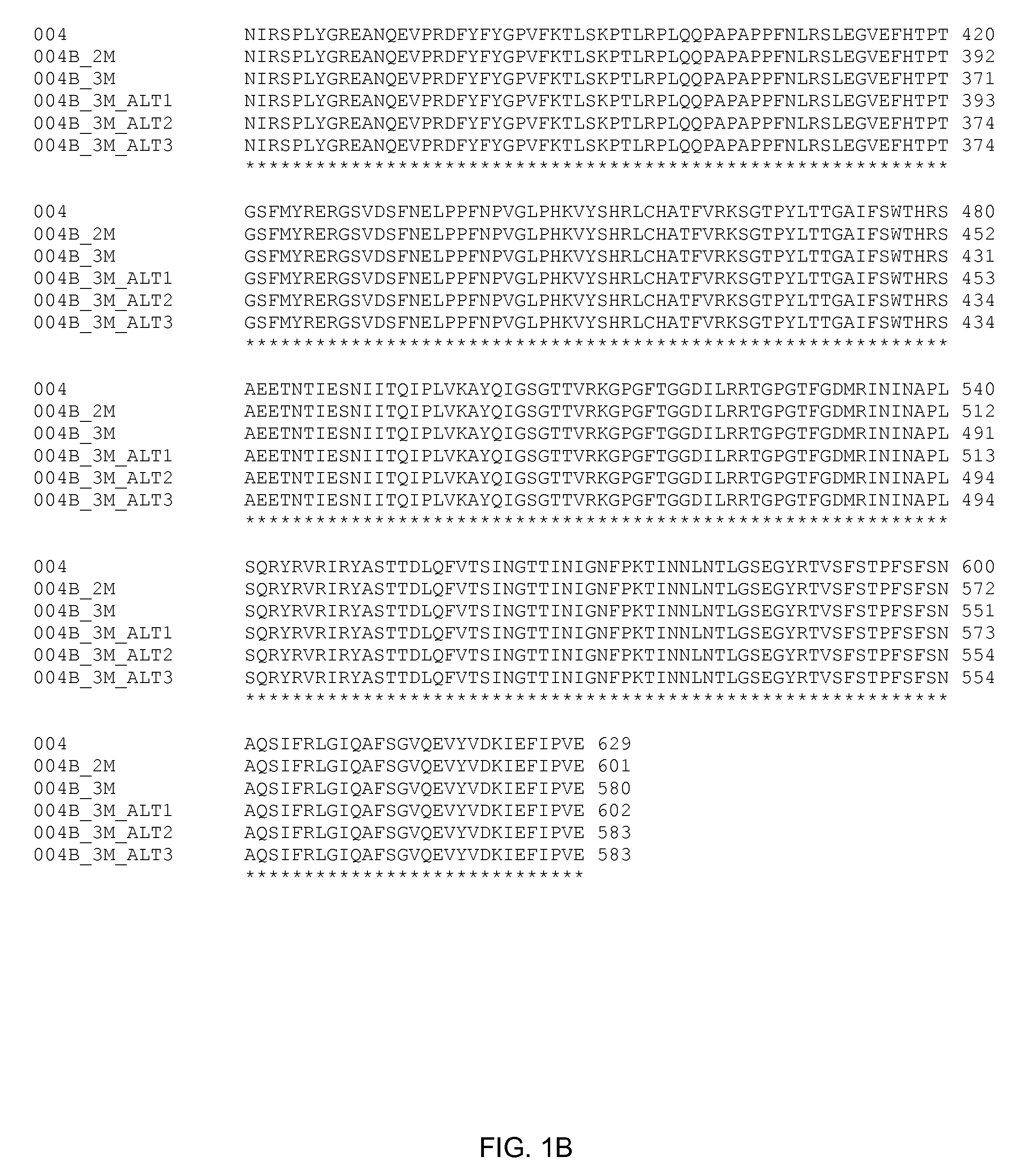Synthetic axmi-004 delta-endotoxin genes and methods for their use
a technology of delta endotoxin and synthetic axmi004 is applied in the field of molecular biology to achieve the effect of preventing the death of the axmi004 gene and preventing the axmi004 from destroying the axmi004 gen
- Summary
- Abstract
- Description
- Claims
- Application Information
AI Technical Summary
Benefits of technology
Problems solved by technology
Method used
Image
Examples
example 1
Generation of Synthetic and Variant Genes
[0099]In one aspect of the invention, synthetic axmi-004 sequences were generated, for example synaxmi-004 (SEQ ID NO:1) and synaxmi-004B (SEQ ID NO:2). These synthetic sequences have an altered DNA sequence relative to the axmi-004 sequence (SEQ ID NO:3) recited in U.S. patent application Ser. No. 10 / 782,020, herein incorporated by reference), and encode the original AXMI-004 protein. Likewise, synaxmi-004B-2M (SEQ ID NO:4) was designed and encodes the axmi-004 alternate start site (herein referred to as axmi-004B-2M and set forth in SEQ ID NO:5) originally identified in U.S. patent application Ser. No. 10 / 782,020.
[0100]In another aspect of the invention, a third start site was identified in the axmi-004 coding sequence. This coding region is designated axmi-004B-3M (SEQ ID NO:16) and encodes the AXMI-004B-3M amino acid sequence set forth in SEQ ID NO:9. Synthetic sequences encoding the AXMI-004B-3M protein were also designed. These syntheti...
example 2
Vectoring of the Pesticidal Genes of the Invention for Plant Expression
[0102]Each of the coding regions of the genes of the invention are connected independently with appropriate promoter and terminator sequences for expression in plants. Such sequences are well known in the art and may include the rice actin promoter or maize ubiquitin promoter for expression in monocots, the Arabidopsis UBQ3 promoter or CaMV 35S promoter for expression in dicots, and the nos or PinII terminators. Techniques for producing and confirming promoter—gene—terminator constructs also are well known in the art.
[0103]Select sequences (Table 1) were expressed in a bacterial host cell and were found to have pesticidal activity against Lepidopteran species.
TABLE 1Vectoring of synthetic and variant sequencesNucleotideAmino acidCloneGene NameSEQ ID NO:SEQ ID NO:Designationsynaxmi-004B-2M45pAX3252synaxmi-004B-3M69pAX4538synaxmi-004C-3M79pAX3141synaxmi-004D-3M89pAX3142synaxmi-004B-3m-alt11011pAX4522pAX4515synaxmi-...
example 3
Assays for Pesticidal Activity
[0104]The ability of a pesticidal protein to act as a pesticide upon a pest is often assessed in a number of ways. One way well known in the art is to perform a feeding assay. In such a feeding assay, one exposes the pest to a sample containing either compounds to be tested, or control samples. Often this is performed by placing the material to be tested, or a suitable dilution of such material, onto a material that the pest will ingest, such as an artificial diet. The material to be tested may be composed of a liquid, solid, or slurry. The material to be tested may be placed upon the surface and then allowed to dry. Alternatively, the material to be tested may be mixed with a molten artificial diet, then dispensed into the assay chamber. The assay chamber may be, for example, a cup, a dish, or a well of a microtiter plate.
[0105]Assays for sucking pests (for example aphids) may involve separating the test material from the insect by a partition, ideally...
PUM
| Property | Measurement | Unit |
|---|---|---|
| temperature | aaaaa | aaaaa |
| temperature | aaaaa | aaaaa |
| pH | aaaaa | aaaaa |
Abstract
Description
Claims
Application Information
 Login to View More
Login to View More - R&D
- Intellectual Property
- Life Sciences
- Materials
- Tech Scout
- Unparalleled Data Quality
- Higher Quality Content
- 60% Fewer Hallucinations
Browse by: Latest US Patents, China's latest patents, Technical Efficacy Thesaurus, Application Domain, Technology Topic, Popular Technical Reports.
© 2025 PatSnap. All rights reserved.Legal|Privacy policy|Modern Slavery Act Transparency Statement|Sitemap|About US| Contact US: help@patsnap.com


